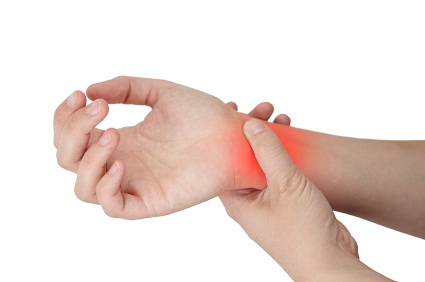- Home
- How to Prevent Rsi
How to prevent RSI when stitching
Knowing how to prevent RSI (or repetitive strain injury) can ensure that you can carry on stitching to your heart's content.
So just what is RSI? It is an inflammation of the tendons which can cause pain and stiffness in your wrist joints.
Not just us needleworkers are at risk of course, anyone whose job or occupation involves doing the same movement repeatedly over a course of time can suffer from symptoms of RSI.

Treatment of repetitive strain injury
The first thing to do if you are showing rsi symptoms is to rest the affected area. Not a welcome suggestion when you desperately want to get on and finish your piece of needlework I know, sorry.
Then I would advise a trip to your doctor to find out if RSI is the cause in case it is something else such as arthritis. If it is diagnosed, the doctor may give you a splint to wear when things are bad (I wear mine overnight) and/or anti-inflammatory tablets.
If this doesn't help he may resort to cortisone injections. I have had these before and just afterwards all I wish is that I hadn't had them! For about three days my hand hurts like mad, but after that the pain decreases and all is well again for a time.
Tips for preventing RSI
Don't hold your embroidery hoop in your hand - attach it to a stand so you can use both hands to stitch rather than gripping the hoop with one of them. Use the stand at its full height if possible to avoid you bending your neck to see what you are doing so that your arms are held at about bust level, with straight wrists. Alternatively you could mount your work into a scroll frame and rest it on the arms of your chair whilst stitching.
Use your non-dominant hand on top and the dominant hand below the work. Once you are used to it, you will find you can stitch quickly and keep your wrists straighter, reducing the risk of pain.
You could try using a double-pointed needle but these take some practice and you may not like them. They may enable you to stab stitch rather than using the sewing motion, which could help keep the pain away longer.
If the doctor has suggested a wrist support, you could wear that whilst stitching or typing. Mine has a metal insert that prevents me bending my hand down. You could also try a Handeze therapeutic support glove to support your wrist.
Cool it! By that I mean use an ice pack to reduce pain in your wrist or elbow.
Use a wrist rest in front of your keyboard. These help hold your wrist in a more natural position. You could even try using your mouse in the other hand. This can feel really tricky at first! You can also get mouse pads with a wrist rest, I find mine invaluable!
If that fails try moving your mouse and mouse mat into your lap. Or you could try a trackball mouse where you move the ball rather than the mouse itself.
Another option is a vertical mouse. The buttons are on the side instead of the top and you hold your hand in a more natural position. It took me a while to get used to mine, but it really did help. Now when I go back to using a normal mouse for any reason, my wrist starts hurting again immediately.
Hopefully these few tips will give you some ideas on how to prevent RSI and enable you to continue stitching.
Visitor comments
After including this article in my March newsletter, Karen from Canada wrote in to share the following tips...
"I am such a fan of your knowledge and thank you for sharing. I enjoyed your article on RSI and would like to add my two cents. Try acupuncture. I am currently having treatments for my arthritic knees and my Carpal Tunnel. The needles hurt in the palm of my hand (can't lie about that) but the results are so worth it. My chiropractor (acupuncturist) also massages my hand, wrist and forearm - what a difference it makes."
Sita also wished to add the following...
"Another point to that is, sometimes problems with the spine and posture will cause pain in the wrist region and could get mistaken for CTS etc. I had this problem, and treatment for Carpel tunnel eased the symptoms but not the problem; I got relief when my posture was corrected. Yoga helps for this."
Thank you for sharing, Karen and Sita. If YOU have any tips you would like to share please do use the new Facebook Commenting feature below.
Stay connected between projects
If you’d like occasional updates from my embroidery room, including new patterns, gentle tips, and little things I think you might enjoy, you’re warmly invited to join the Stitchin’ Times newsletter.
No pressure. Just a friendly note now and then to keep you inspired.